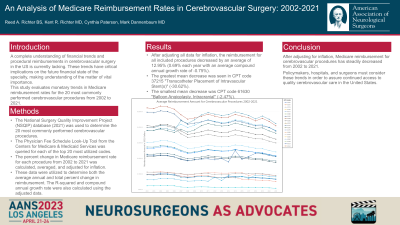An Analysis of Medicare Reimbursement Rates in Cerebrovascular Surgery: 2002-2021
Friday, April 21, 2023


Reed A. Richter, BS
Medical Student
McGovern Medical School at UTHealth Houston
Houston
ePoster Presenter(s)
Introduction: A complete understanding of financial trends and procedural reimbursements in cerebrovascular surgery in the US is currently lacking. These trends have critical implications on the future financial state of the specialty, making understanding of the matter of vital importance. This study evaluates monetary trends in Medicare reimbursement rates for the 20 most commonly performed cerebrovascular procedures from 2002 to 2021.
Methods: The National Surgery Quality Improvement Project (NSQIP) database (2021) was used to determine the 20 most commonly performed cerebrovascular procedures. The Physician Fee Schedule Look-Up Tool from the Centers for Medicare & Medicaid Services was queried for each of the top 20 most utilized codes. The percent change in Medicare reimbursement rate for each procedure from 2002 to 2021 was calculated, averaged, and adjusted for inflation. These data were utilized to determine both the average annual and total percent change in reimbursement. The R-squared and compound annual growth rate were also calculated using the adjusted data.
Results: After adjusting all data for inflation, the reimbursement for all included procedures decreased by an average of 12.95%. The greatest mean decrease was seen in CPT code 37215 "Transcatheter Placement of Intravascular Stent(s)" (-30.62%), while the smallest mean decrease was CPT code 61630 "Balloon Angioplasty, Intracranial" (-2.47%). From 2002 to 2021, the adjusted reimbursement rate for all included procedures decreased by an average of 0.69% each year with an average compound annual growth rate of -0.75%.
Conclusion : After adjusting for inflation, Medicare reimbursement for cerebrovascular procedures has steadily decreased from 2002 to 2021. Policymakers, hospitals, and surgeons must consider these trends in order to assure continued access to quality cerebrovascular care in the United States.
Methods: The National Surgery Quality Improvement Project (NSQIP) database (2021) was used to determine the 20 most commonly performed cerebrovascular procedures. The Physician Fee Schedule Look-Up Tool from the Centers for Medicare & Medicaid Services was queried for each of the top 20 most utilized codes. The percent change in Medicare reimbursement rate for each procedure from 2002 to 2021 was calculated, averaged, and adjusted for inflation. These data were utilized to determine both the average annual and total percent change in reimbursement. The R-squared and compound annual growth rate were also calculated using the adjusted data.
Results: After adjusting all data for inflation, the reimbursement for all included procedures decreased by an average of 12.95%. The greatest mean decrease was seen in CPT code 37215 "Transcatheter Placement of Intravascular Stent(s)" (-30.62%), while the smallest mean decrease was CPT code 61630 "Balloon Angioplasty, Intracranial" (-2.47%). From 2002 to 2021, the adjusted reimbursement rate for all included procedures decreased by an average of 0.69% each year with an average compound annual growth rate of -0.75%.
Conclusion : After adjusting for inflation, Medicare reimbursement for cerebrovascular procedures has steadily decreased from 2002 to 2021. Policymakers, hospitals, and surgeons must consider these trends in order to assure continued access to quality cerebrovascular care in the United States.
